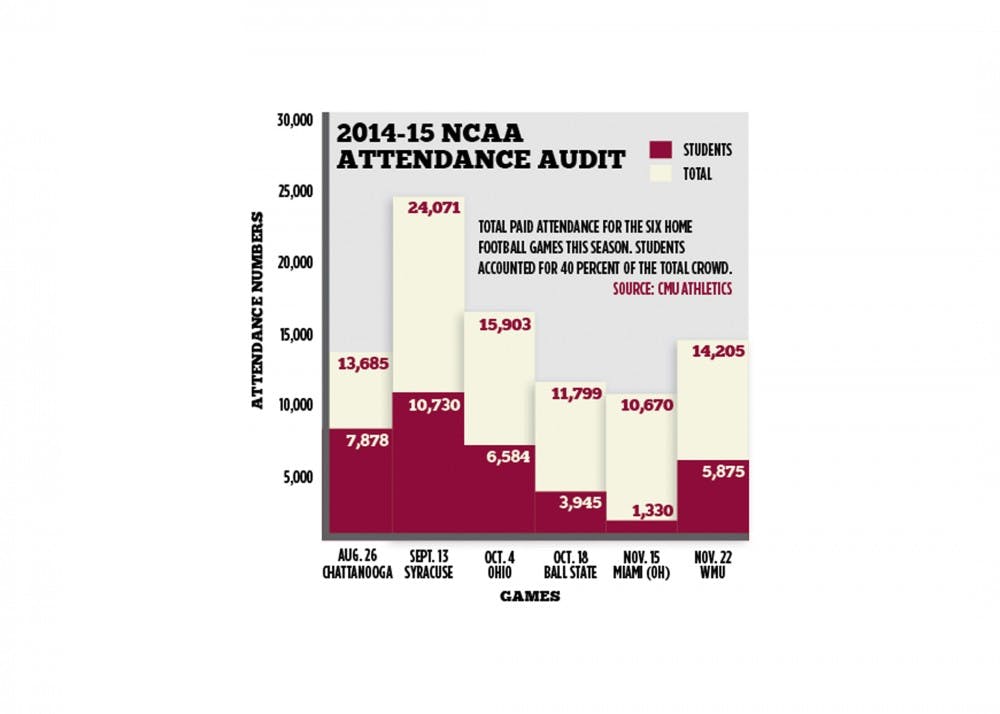Football audit shows increases in student participation, general admission
Audited attendance numbers for the 2014-15 Central Michigan University football season show an increase in student engagement and less reliance on IMG College ticket distribution to remain compliant with NCAA requirements.
Sent to the NCAA Feb. 15, the internal audit is conducted by the university and signed by University President George Ross and Athletics Director Dave Heeke. The NCAA Division I requires CMU, as a member of the Football Bowl Subdivision, to average at least 15,000 in actual or paid attendance for all home football games on a two-year rolling basis.
CMU's report shows its compliance, averaging 15,056 in paid attendance for 2014 home games. For the 2013 football season, CMU averaged 15,333 in paid attendance. This year, students accounted for 40 percent of the overall crowd throughout six home games.
"That's really what we are continuing to try to focus on, is the connection between our staff our student-athletes and our student body," said Criag Willey, senior associate athletic director of External Operations. "They are our No. 1 customer on any given day. The students are the largest segment of our audience in that stadium."
Associate Athletic Director for Corporate Sales and Marketing Nick Williams said there are a variety of factors that influence home game attendance, but this year's success can be attributed to a favorable schedule and effective student engagement initiatives.
"We opened the season with a Thursday night game against Chattanooga and that's always a really big student night for us," Williams said. "Then we followed up with an early-September Saturday game against an Atlantic Coast Conference opponent. The dates and the schedule for us were more favorable in terms of lending us the opportunity to have a good crowd in general."
Students made up 57 percent of the home crowd in the Aug. 26 game against the University of Tennessee Chattanooga. The Sep. 13 game against Syracuse attracted 10,730 students, the most all season.
These numbers are a measured improvement over the previous season, where students averaged 3,064 in paid attendance, accounting for 20 percent of the total number of fans on game day.
Students did not account for more than 30 percent of the total paid attendance in a single game last season, while this year it averaged over 33 percent in all but one game. The Nov. 15 Miami Ohio game had the worst turnout of the season, students made up 12 percent of the 10,670 overall attendance number.
Attendance numbers historically decline as the season progresses and the weather gets colder, but the final home game against Western Michigan University was the third-highest attended game of the season and attracted students to make up 41 percent of the crowd.
With the Mid-American Conference signing a 13-year television deal with ESPN guaranteeing broadcast coverage of every MAC football game, convincing fans to enter the stadium becomes even more crucial.
Williams said student participation strategies were implemented at the beginning of the year by opening the Kelly/Shorts Stadium to students get students at Leadership Safari and MAINStage on the field and familiar with CMU football. He said they have also worked to improve the game-day experience, adding more promotional games and giveaways to involve students.
Junior Santino Vitelli said he attended two home games this season and noticed the focus on more promotions in the student section.
"Giving out free T-shirts helped give me another reason to be there. I went for the shirt," Vitelli said.
Shelby Township sophomore Nicholas Barton said he attended no home games last year, but went to a few this season based on the success of the team.
"It's a fun and engaging environment, we had student section leaders on the field creating that fan friendly environment," Willey said. "All the promotion contestants we chose this year came out of the student section, so every time you came to the game as a student you were there with the team and you get to play a big part in the game."
Vitelli and Barton attended every tailgate this season, despite entering the stadium in less than half of the games.
Williams said it is important to make the student section have an identity as a shared space that connects students to the action on the field. CMU was 3-3 at home this season but was close in every game, being outscored 130-127 overall.
Previously located from section L to U, the student section was moved to run section U to AA on the east side of the stadium, behind the home bench. Students are on the opposite end of the press box, so when CMU is featured on TV or online, cameras will focus on the students and band. Barton said the student section this year had a "more enjoyable, hyped up atmosphere" during games.
Ticket Sales
Sections L to T were dedicated to general admission seats and visiting fans this season, while season ticket holder seats were not affected. Willey said this opened the opportunity for a focus on selling general admission tickets.
"I think ticket sales in general are important and you can't just put that premium on season tickets; for us selling that single game ticket is just as important," Willey said. "We look to attract single game tickets and get them to become season ticket owners."
Over 8,000 tickets were consistently sold at each home game, coming mostly from general admission ticket sales.
CMU earned $53,043 per game from season ticket sales this year, compared to $88,176 per game last year. The Sept. 13 Syracuse game sold 9,762 general admission tickets to earn $143,422, the most this season.
Last season, CMU was heavily reliant on IMG College distributing 5,500 season tickets to stay compliant with the NCAA. This year, IMG was only given 1,200 tickets to distribute.
"It's part of the benefit, through the sponsorship sales and IMG we can help achieve the paid attendance of 15,000," Willey said. "This year we had better attendance and student participation we didn't need as many of those tickets to hit that threshold."
Willey said the number of tickets sold to IMG is determined year by year based on how sure CMU is to make the 15,000 mark.
Football is the highest revenue generating sport at CMU. Its $2.1 million accounts for 30 percent $7.1 million revenue generated by the Athletics Department this year.
It is also the most expensive. Football expenses totaled $3.8 million this year. The next closest sport was men's basketball, which cost $1.2 million this year.
Methodology
According to the statistics guidelines and policies released by the NCAA, "Attendance figures for official box scores and/or NCAA reports can be calculated by turnstile count, tickets sold or estimates. Schools should make every effort to record an attendance figure on each statistical box score it produces." If these figures are not met, CMU would not be eligible to play any postseason game.
CMU subscribes to the paid attendance requirement, which counts tickets sold for at least one-third of the highest established ticket price, regardless of whether they are used for admission. Tickets sold at less than one-third of that price were only counted if admitted.
This means tickets sold count for bodies in the seats, regardless of if the person physically enters the stadium or not.
No attendees or students performing services at the stadium, such as concessionaires, ticket takers, parking lot attendants, ushers or groundskeepers, are not included. However, band members performing at the event are included in the count as any other student.
"15,000 is a requirement, we feel very confident that we will hit that mark year in and year out," Willey said. "Our focus is to get as many people in that stadium on a game-by-game basis. We're not as focused on that number as a gauge of good or bad because there are a lot of things that impact attendance."
Next year, CMU will host two mid-week games and open the conference schedule at home. Before the MAC seasons starts, CMU will face schools from the Big 12, ACC and Big Ten.
Willey said it is vital that CMU is hosting four home games before late-October, because it allows fans to take advantage of fairer weather before fall ends. The season begins Thursday, Sept. 3 vs. Oklahoma State, followed by a Saturday, Sept. 12 game against Monmouth.
CMU takes on Northern Illinois on Saturday, Oct. 3 and Buffalo Oct. 17 before ending their season with a Tuesday and Friday game Nov. 10 against Toledo and Nov. 27 against Eastern Michigan.







